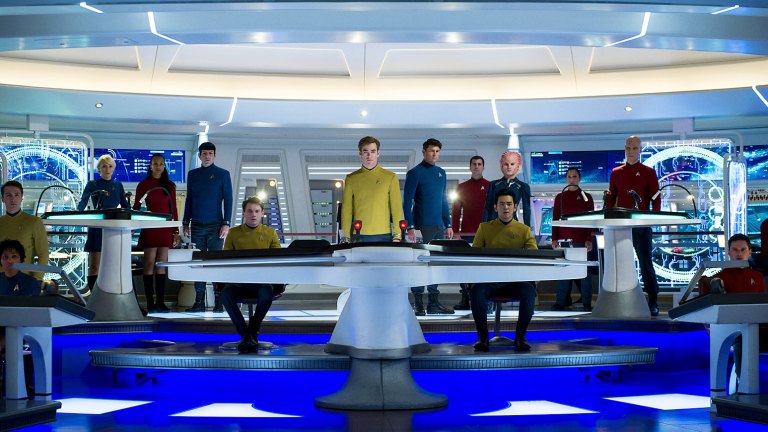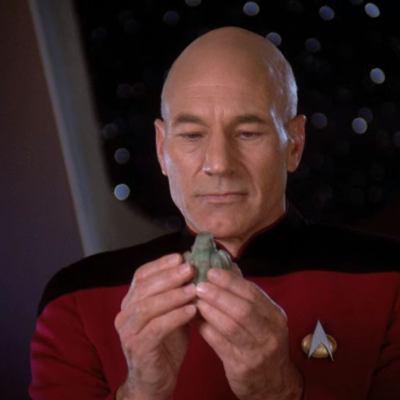Why Star Trek 2009’s Enterprise Bridge Looked Like an Apple Store
The J.J. Abrams Star Trek reboot changed canonical time travel rules in one way we rarely talk about.

Other than a lot of lens flare, one aspect of the J.J. Abrams Star Trek reboot that haters loved to bring up was the fact that the Enterprise bridge kind of looked like an Apple store. Whether or not this fact dates the movie more than the style of the ‘60s bridge, or the laid-back Next Gen bridge is up for debate. But, within the context of the movie, the reason why the technology on Chris Pine’s USS Enterprise looks “better” than William Shatner’s Enterprise has an in-universe explanation. And, when Trekkies get into it about the various zigs-and-zags of the Kelvin Universe versus the Prime Universe, one very interesting detail from the 2009 Trek tends to get left out. Star Trek 2009 is streaming now on Netflix, so, let’s explore the Enterprise in the room: The souped-up-tech used by reboot Starfleet comes from reverse-engineered tech from the future of the Prime Universe. But who “invented” it? And how many technological bootstrap paradoxes are keeping the lights on in the Star Trek canon?
Although it is never stated outright in the film, both screenwriter Roberto Orci and director J.J. Abrams publicly confirmed that the reason why the technology of the alternate 2258 looks so much more advanced than the 23rd century of The Original Series is that the USS Kelvin’s shuttles took scans of the time-traveling 24th century Romulan ship — the Narada. According to Orci, Starfleet clearly reverse-engineered the future-tech technology from the Narada to create more advanced technology, much earlier than they did in the Prime Timeline. Responding to fan posts on Ain’t It Cool in 2009, Orci said, “Imagine the wealth of information that Starfleet was exposed to from scans of the Narada.”
Abrams backed this idea of paradoxical time-travel Trek-tech advances, by telling MTV in 2009 that the scans from the Narada “inspired ideas and technology that wouldn’t have advanced otherwise.” So, your shiny Apple Store USS Enterprise exists because of reverse-engineered time travel tech. These details get even stranger when you factor in the quasi-canon 2009 IDW prequel comic Star Trek: Countdown, which revealed that the Narada was souped-up in the 24th Century with reverse-engineered Borg tech, captured by the Romulans. In 2020, Star Trek: Picard created a possible canonical link to that idea, by demonstrating that the Romulans had been harvesting tech from a damaged Borg Cube called “The Artifact.” Because the Artifact conked out in Romulan space sometime in the early 2380s, and Nero went back in time in 2387, this pretty much checks out. (This is why I’m calling Countdown quasi-canon. Picard justifies the Romulan-Borg tech connection.) The Narada was the product of reverse-engineered Borg tech, and the Starfleet ships of the Kelvin timeline were the result of reverse-engineering the future tech from the Narada. That’s a lot of reverse engineering!
So, why is that a big deal? The tech of the Kelvin timeline ripped off cool stuff from an alternate future they never saw? Well, Star Trek: Discovery Season 3 outright acknowledged the existence of the Kelvin Timeline for the first time in the prime canon. But, before that, in Season 2, Discovery also floated the idea that within the Prime timeline, that huge leaps forward in technology might be attributed to time travel. In the Season 2 DISCO episode “The Red Angel,” we learn that Section 31 was in a “temporal arms race” against the Klingons early in the 23rd century. On top of that, it’s stated outright that some sudden leaps-forward in technology within the Prime Timeline, could be the result of time travel. Discovery even presents some evidence of this; Ash Tyler uses a TNG-style com-badge in Season 2, about a century before Starfleet is supposed to have that tech, leaving Captain Pike in shock!
Prior to Star Trek 2009, there were some indications that bootstrap paradoxes caused by time travel also created important technology. In The Voyage Home, Scotty shrugs his shoulders about giving the formula for transparent aluminum to Dr. Nichols in the 20th century by telling Bones, “how do we know he didn’t invent the thing?” In First Contact, much of the plot hinges on the crew of the Enterprise-E using their technology to retrofit the 21st century Phoenix so it can achieve its first warp drive flight. Basically, people from the future helped to make sure warp drive was invented on Earth to ensure their future.
The thing is, in First Contact and The Voyage Home, these bootstrap paradoxes aren’t taken too seriously, or, at the very least, you’re supposed to infer that maybe there was a slightly different timeline that occurred before, meaning the technology itself didn’t “originally” come from a paradox. But is that true? In the prequel series Enterprise, it was established that the “new” post-First Contact Prime timeline was one in which Zefram Cochrane knew about the Borg and the future, which really makes you wonder if there was ever another timeline in which the Enterprise-E crew didn’t make sure that the Phoenix warp flight took place. We’ve always been told you need dilithium crystals to make warp speed happen, but it’s not like Zefram Cochrane had any of those lying around. Did Geordi loan him some? Who invented Warp Drive then? Who really composed Beethoven’s 5th?
From Doctor Who to Harry Potter, we’re used to these kinds of paradoxes being tossed off as a jokey plotpoint. Harry learns how to do his patronus by watching himself do it thanks to the Time Turner. The 11th Doctor got himself out of the Pandorica because paradoxes are just as hilarious and cool as bowties and fezzes. Star Trek likes to joke about paradoxes too, of course. In “Trials and Tribble-ations,” O’Brien thinks it’s hilarious that Bashir might be destined to become his own ancestor, via a predestination paradox. But, with most of these examples, nothing actually changes in what the audience perceives. It’s mostly lampshading for the purposes of having a good time with the audience, because isn’t sci-fi zany?
What makes the time travel tech paradox backstory of Trek 2009 different is that it creates a different statement for how to think about time travel. As Discovery Season 2 inferred, a bunch of Starfleet tech (and Klingon tech) might not exist if it weren’t for time travel. So, instead of time travel becoming a fun story element, or even a moral conundrum (like in “City on the Edge of Forever”) this kind of wibbly-wobbly time travel does something else. It’s not just storytelling. After Trek 2009, time travel also became an important building block to world building.
Star Trek 2009 is streaming now on Netflix.


